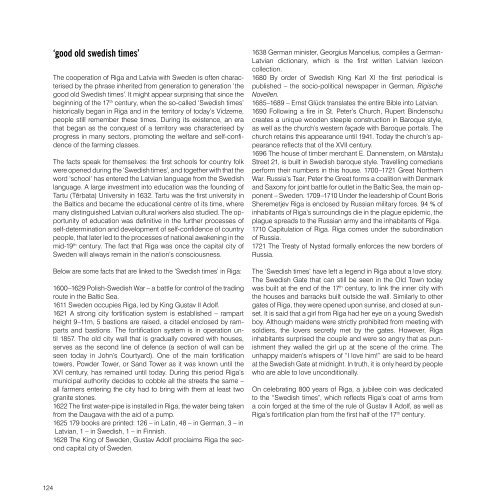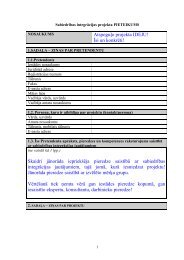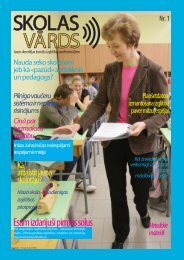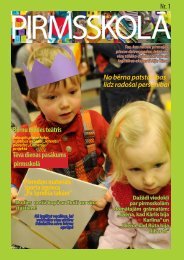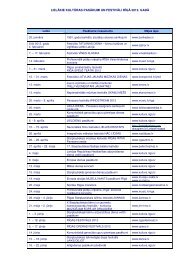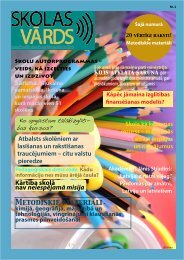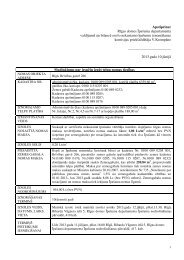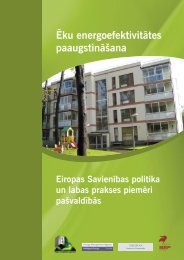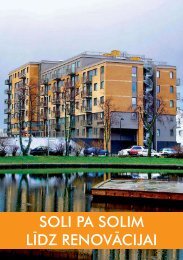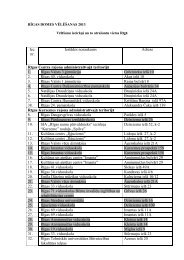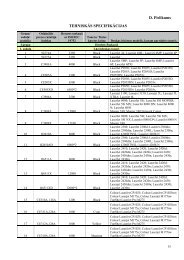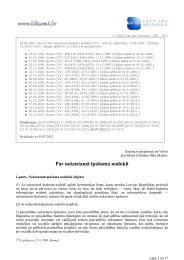Riga - European Capital of Culture 2014 candidate
Riga - European Capital of Culture 2014 candidate
Riga - European Capital of Culture 2014 candidate
- No tags were found...
You also want an ePaper? Increase the reach of your titles
YUMPU automatically turns print PDFs into web optimized ePapers that Google loves.
‘good old swedish times’The cooperation <strong>of</strong> <strong>Riga</strong> and Latvia with Sweden is <strong>of</strong>ten characterisedby the phrase inherited from generation to generation ‘thegood old Swedish times’. It might appear surprising that since thebeginning <strong>of</strong> the 17 th century, when the so-called ‘Swedish times’historically began in <strong>Riga</strong> and in the territory <strong>of</strong> today’s Vidzeme,people still remember these times. During its existence, an erathat began as the conquest <strong>of</strong> a territory was characterised byprogress in many sectors, promoting the welfare and self-confidence<strong>of</strong> the farming classes.The facts speak for themselves: the first schools for country folkwere opened during the ‘Swedish times’, and together with that theword ‘school’ has entered the Latvian language from the Swedishlanguage. A large investment into education was the founding <strong>of</strong>Tartu (Tērbata) University in 1632. Tartu was the first university inthe Baltics and became the educational centre <strong>of</strong> its time, wheremany distinguished Latvian cultural workers also studied. The opportunity<strong>of</strong> education was definitive in the further processes <strong>of</strong>self-determination and development <strong>of</strong> self-confidence <strong>of</strong> countrypeople, that later led to the processes <strong>of</strong> national awakening in themid-19 th century. The fact that <strong>Riga</strong> was once the capital city <strong>of</strong>Sweden will always remain in the nation’s consciousness.Below are some facts that are linked to the ‘Swedish times’ in <strong>Riga</strong>:1600–1629 Polish-Swedish War – a battle for control <strong>of</strong> the tradingroute in the Baltic Sea.1611 Sweden occupies <strong>Riga</strong>, led by King Gustav II Adolf.1621 A strong city fortification system is established – rampartheight 9–11m, 5 bastions are raised, a citadel enclosed by rampartsand bastions. The fortification system is in operation until1857. The old city wall that is gradually covered with houses,serves as the second line <strong>of</strong> defence (a section <strong>of</strong> wall can beseen today in John’s Courtyard). One <strong>of</strong> the main fortificationtowers, Powder Tower, or Sand Tower as it was known until theXVI century, has remained until today. During this period <strong>Riga</strong>’smunicipal authority decides to cobble all the streets the same –all farmers entering the city had to bring with them at least twogranite stones.1622 The first water-pipe is installed in <strong>Riga</strong>, the water being takenfrom the Daugava with the aid <strong>of</strong> a pump.1625 179 books are printed: 126 – in Latin, 48 – in German, 3 – inLatvian, 1 – in Swedish, 1 – in Finnish.1628 The King <strong>of</strong> Sweden, Gustav Adolf proclaims <strong>Riga</strong> the secondcapital city <strong>of</strong> Sweden.1638 German minister, Georgius Mancelius, compiles a German-Latvian dictionary, which is the first written Latvian lexiconcollection.1680 By order <strong>of</strong> Swedish King Karl XI the first periodical ispublished – the socio-political newspaper in German, RigischeNovellen.1685–1689 – Ernst Glück translates the entire Bible into Latvian.1690 Following a fire in St. Peter’s Church, Rupert Bindenschucreates a unique wooden steeple construction in Baroque style,as well as the church’s western façade with Baroque portals. Thechurch retains this appearance until 1941. Today the church’s appearancereflects that <strong>of</strong> the XVII century.1696 The house <strong>of</strong> timber merchant E. Dannenstern, on MārstaļuStreet 21, is built in Swedish baroque style. Travelling comediansperform their numbers in this house. 1700–1721 Great NorthernWar. Russia’s Tsar, Peter the Great forms a coalition with Denmarkand Saxony for joint battle for outlet in the Baltic Sea, the main opponent– Sweden. 1709–1710 Under the leadership <strong>of</strong> Count BorisSheremetjev <strong>Riga</strong> is enclosed by Russian military forces. 94 % <strong>of</strong>inhabitants <strong>of</strong> <strong>Riga</strong>’s surroundings die in the plague epidemic, theplague spreads to the Russian army and the inhabitants <strong>of</strong> <strong>Riga</strong>.1710 Capitulation <strong>of</strong> <strong>Riga</strong>. <strong>Riga</strong> comes under the subordination<strong>of</strong> Russia.1721 The Treaty <strong>of</strong> Nystad formally enforces the new borders <strong>of</strong>Russia.The ‘Swedish times’ have left a legend in <strong>Riga</strong> about a love story.The Swedish Gate that can still be seen in the Old Town todaywas built at the end <strong>of</strong> the 17 th century, to link the inner city withthe houses and barracks built outside the wall. Similarly to othergates <strong>of</strong> <strong>Riga</strong>, they were opened upon sunrise, and closed at sunset.It is said that a girl from <strong>Riga</strong> had her eye on a young Swedishboy. Although maidens were strictly prohibited from meeting withsoldiers, the lovers secretly met by the gates. However, <strong>Riga</strong>inhabitants surprised the couple and were so angry that as punishmentthey walled the girl up at the scene <strong>of</strong> the crime. Theunhappy maiden’s whispers <strong>of</strong> “I love him!” are said to be heardat the Swedish Gate at midnight. In truth, it is only heard by peoplewho are able to love unconditionally.On celebrating 800 years <strong>of</strong> <strong>Riga</strong>, a jubilee coin was dedicatedto the “Swedish times”, which reflects <strong>Riga</strong>’s coat <strong>of</strong> arms froma coin forged at the time <strong>of</strong> the rule <strong>of</strong> Gustav II Adolf, as well as<strong>Riga</strong>’s fortification plan from the first half <strong>of</strong> the 17 th century.a contemporary tale <strong>of</strong> cooperation with swedenThe historical ‘Swedish foundations’ serve for the close cooperation<strong>of</strong> <strong>Riga</strong> and Swedish cities – from the political, financial andeconomic sector to science, the environmental field and web <strong>of</strong>contacts in the cultural sector. In accordance with informationfrom the Bank <strong>of</strong> Latvia, today Sweden is the second largest investorin Latvia. Quick-witted analysts, when talking about thisfact, call these the ‘new Swedish times’.A considerable contribution by Sweden to the educational development<strong>of</strong> Latvia and the Baltics is the establishment <strong>of</strong> theSchool <strong>of</strong> Economics in <strong>Riga</strong> and <strong>Riga</strong> Graduate School <strong>of</strong> Law.Various schools have cooperation with Swedish universities. Thepartner organisations <strong>of</strong> the Latvian Academy <strong>of</strong> Science arethe Swedish Royal Academy <strong>of</strong> Science and the Swedish RoyalAcademy <strong>of</strong> Humanitarian Sciences, History and Artefacts. TheNordic Centre <strong>of</strong> the Latvian Academy <strong>of</strong> <strong>Culture</strong> implements cooperationbetween Latvia, Sweden and other Northern countriesin the cultural sector, promoting Nordic studies and research inLatvia.Cooperation with Sweden in the cultural sector is very active. Asignificant event in 2008 was the participation <strong>of</strong> Latvia in the status<strong>of</strong> main guest country at the Annual Book Fair in Goteborg inSeptember. The National Concert Agency Latvijas koncerti haslong-standing cooperation with Rikskonserter – the concert agencynetwork for Scandinavian-Baltic countries. The participation<strong>of</strong> the Latvian National Opera at the Dalhalla opera festival hasbecome a tradition. Other areas <strong>of</strong> cooperation: traditional art, archives,library sciences, museums, cultural education, monumentprotection. Latvia takes part in film and theatre festivals takingplace in Sweden.‘new swedish times’Cooperation <strong>of</strong> <strong>Riga</strong> with Lund and Umeå in the <strong>European</strong> <strong>Capital</strong><strong>of</strong> <strong>Culture</strong> project.During the preparation period <strong>of</strong> the application, <strong>Riga</strong>’s taskgroup has met with representatives from Lund and Umeå, agreeingon the main directions for city cooperation under the <strong>2014</strong><strong>European</strong> <strong>Capital</strong> <strong>of</strong> <strong>Culture</strong>. The cities have agreed that regardless<strong>of</strong> which city obtains the honour <strong>of</strong> organising ECC, the initiatedcontacts should be implemented at least in some <strong>of</strong> theindividual projects.riga and umeå1. <strong>Riga</strong> and Umeå are proud <strong>of</strong> their indigenous inhabitants, theLivs and the Sami people, two nations that belong to the group<strong>of</strong> Finno-Ugric languages. Over 800 years ago <strong>Riga</strong> was foundedon the site <strong>of</strong> the Liv settlement, but today in <strong>Riga</strong> there is still acommunity <strong>of</strong> Livs, even though they are maybe just a few dozen,that have united in the <strong>Riga</strong> Union <strong>of</strong> Livs and are actively involvedin the project development with Umeå. In turn, Umeå is proud<strong>of</strong> its Sami heritage and the contemporary contribution <strong>of</strong> Samitraditions by Sami inhabitants <strong>of</strong> the city. <strong>Riga</strong> and Umeå haveagreed as follows:• By <strong>2014</strong> to initiate a Sami and Liv 3 generation exchangeprogramme within the framework <strong>of</strong> family summer camps. Eachyear on the Liv coast at Mazirbe, a Liv family camp takes place fora week, where skills in the Liv language, songs and traditions arelearned in a relaxed atmosphere, which traditionally closes withthe Liv festival in the first weekend in August. The festival has alsobeen attended by the heads <strong>of</strong> countries <strong>of</strong> Latvia, Estonia andFinland. The friendship <strong>of</strong> Liv and Sami families at such camps inLatvia and Sweden would allow the Finno-Ugric traditions to liveon in the new generations and promote opportunities for longlastingcontact between people on both sides.• The young adults’ section <strong>of</strong> the Liv union is well known for itsmusicality, playing music both in a traditional style and in variousmodern genres <strong>of</strong> music. Similarly, there are talented young Samiadults in Umeå who perform contemporary Finno-Ugric music.Both sides are interested in the creation <strong>of</strong> a Sami and Liv musicproject for young adults.• Sami and Liv Day in Brussels: a jointly organised project dedicatedto the significance <strong>of</strong> small nations and languages in thediversity <strong>of</strong> <strong>European</strong> culture.• An international conference for the rights <strong>of</strong> indigenous people.Each autumn in Sweden the international Human Rights Daystake place, and the Sami Society in Sweden has begun to developan idea together with the UN about the organisation <strong>of</strong> suchan international event in Umeå in <strong>2014</strong>, with the Livs as one <strong>of</strong> theguests <strong>of</strong> honour.• Traditional Sami and Liv cuisine – in the sense <strong>of</strong> ‘high art’.Cooperation with the “Slow-food Latvia” movement, representatives<strong>of</strong> the union and restaurants in both cities.• A modern Sami and Liv design cooperation project “Etn<strong>of</strong>utu”.The potential cooperation partner on the Latvian side is the DesignSection <strong>of</strong> the Latvian Academy <strong>of</strong> Art.124 125


